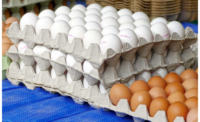How to Prepare Food & Beverage Packaging for E-Grocery

Do you know how to prepare your packaging for the grocery side of e-commerce? This Q&A, with Alexandre de Souza Carvalho, director of marketing services at Tetra Pak (tetrapak.com) will answer this question and more for food and beverage manufacturers, producers and retailers.
How should food and beverage producers prepare their packaging for e-commerce? When speaking to package design, what features are consumers demanding?
Packaging is the key to e-commerce, with an overwhelming majority of consumers saying it can either have a positive impact or ruin an otherwise positive purchase experience. Package design can play a value-added service in a consumer’s journey when they shop online. For example, take the unboxing experience, where there is still significant opportunity for e-retailers to enhance the consumer experience by improving the way the package looks and performs. Our research found that 38% had no product brand on the secondary packing, inside or outside, and 30 percent did not reflect the value of the brand. When developing package design for e-commerce, food and beverage producers should consider the following consumer demands:
- Convenience is the main driver of online grocery across markets as consumers want shopping that’s faster and easier than ever before. Food and beverage producers can tap into this trend by providing convenient packaging, like packaging that’s easy to open, robust and lightweight, and can be safely delivered without the need for excess secondary packaging. By 2025, space efficient and ‘frustration-free’ packaging is expected to become a basic requirement from consumers.
- Demand for sustainable packaging is also on the rise globally, so where possible, food and beverage producers should avoid unnecessary secondary packaging and make sure it is recyclable. Plastic packaging is under severe pressure with high profile initiatives under way to reduce its impact on the environment, especially the oceans, and so as public concern increases, food and beverage producers should look to plastic alternatives.
- Lightweight, logistically efficient packaging, such as cartons, has a valuable role to play in online grocery, both in reducing shipping costs and carbon footprint.
How will more e-commerce food and beverage sales affect secondary packaging? How should producers think about their secondary packaging to e-retailers?
People shopping via e-grocery are highly critical of secondary packaging, which they often consider to be both unnecessary and environmentally unfriendly. According to the Tetra Pak survey, 80 percent of consumers in South Korea – the most developed country for e-commerce — and 74 percent in the U.S. say they would avoid goods with several layers of packaging for environmental reasons.
From an e-retailer perspective, secondary packaging, such as film wrap on product trays, adds considerable time and complexity, and some e-commerce pure players report that removing such packaging prior to repacking for fulfilment accounts for 10 percent of costs. As online grocery sales increase, and the race to optimize efficiencies accelerates, food and beverage producers need to have a closer look at their packaging and come up with robust but lightweight solutions that create value in an increasingly omni-channel marketplace.
How do you balance design and technology to create a great product for the customer?
Personalization is crucial to building brand loyalty and tailoring the shopping experience for consumers. Using technology, brands are tapping into customer data collected across digital touchpoints, be that when they order online, or through smart packaging features, to solve complex and personal challenges for consumers one-on-one. Through innovative radio frequency identification (RFID) and unique code identifiers on packages, e-retailers have seen up to 30% increases of a specific brand’s sales, allowing them to leverage their deep customer data to identify the most desirable, and profitable products. Data is even being used by food and beverage producers to create custom products in smaller batches. This is contributing to an ongoing shift in the balance of power from brands to e-retailers, who possess the biggest store of personal data and can therefore “own” the consumer relationship – while developing their own private label offering.
How does smart packaging open marketing opportunities for consumers and what does the future of smart packaging look like?
Digital printing is vital to smart packaging technology, creating opportunities for consumer interaction, which allows producers to print a unique digital code on every package. These codes can then be scanned by smartphones or special devices, leading to innovative possibilities:
- With a supply chain that’s interlinked from end-to-end, brands can make traceability more transparent, sharing information with consumers right down to the farm or grove that a particular product originated.
- The package can be the gateway to a customer engagement program: a lottery ticket, a unique identifier for an online competition, a loyalty token or a means of creating a one-to-one channel with individual consumers.
- The information flow can be two-way, allowing producers to capture specific, valuable information about their consumers as part of the digital code interaction.
With Tetra Pak producing some 188 billion packages last year, the potential reach of digital packaging is substantially greater than any social media platform. As reported in the Tetra Pak Index last year, 65 percent of the most influential online consumers in both the U.S. and U.K. would be very interested in such package interactivity, rising to 89 percent in China, where QR scanning is more commonplace and where such digital packages are already successful. As technology advances, smart packaging will become ever more significant globally in both upstream and downstream logistics through the use of unique data codes.
Looking for a reprint of this article?
From high-res PDFs to custom plaques, order your copy today!







